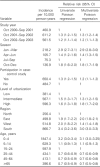A case-control study of acute respiratory tract infection in general practice patients in The Netherlands
- PMID: 16028157
- PMCID: PMC7107976
- DOI: 10.1086/431982
A case-control study of acute respiratory tract infection in general practice patients in The Netherlands
Abstract
Background: Acute respiratory tract infections (ARTIs) are responsible for considerable morbidity in the community, but little is known about the presence of respiratory pathogens in asymptomatic individuals. We hypothesized that asymptomatic persons could have a subclinical infection and thus act as a source of transmission.
Methods: During the period of 2000-2003, all patients with ARTI who visited their sentinel general practitioner had their data reported to estimate the incidence of ARTI in Dutch general practices. A random selection of these patients (case patients) and an equal number of asymptomatic persons visiting for other complaints (control subjects) were included in a case-control study. Nose and throat swabs of participants were tested for a broad range of pathogens.
Results: The overall incidence of ARTI was 545 cases per 10,000 person-years, suggesting that, in the Dutch population, an estimated 900,000 persons annually consult their general practitioner for respiratory complaints. Rhinovirus was most common in case patients (24%), followed by influenza virus type A (11%) and coronavirus (7%). Viruses were detected in 58% of the case patients, beta -hemolytic streptococci group A were detected in 11%, and mixed infections were detected in 3%. Pathogens were detected in approximately 30% of control subjects, particularly in the youngest age groups.
Conclusion: This study confirms that most ARTIs are viral and supports the reserved policy of prescribing antibiotics. In both case and control subjects, rhinovirus was the most common pathogen. Of bacterial infections, only group A beta-hemolytic streptococci were more common in case patients than in control subjects. Furthermore, we demonstrated that asymptomatic persons might be a neglected source of transmission.
Figures







Comment in
-
Etiologies of acute respiratory tract infections.Clin Infect Dis. 2005 Aug 15;41(4):503-6. doi: 10.1086/432019. Epub 2005 Jul 15. Clin Infect Dis. 2005. PMID: 16028159 Free PMC article. No abstract available.
References
-
- Gwaltney JM. Clinical significance and pathogenesis of viral respiratory infections. Am J Med. 2002;112(Suppl 6A):13–8. - PubMed
MeSH terms
LinkOut - more resources
Full Text Sources
Other Literature Sources
Medical

